Other Lines to South America
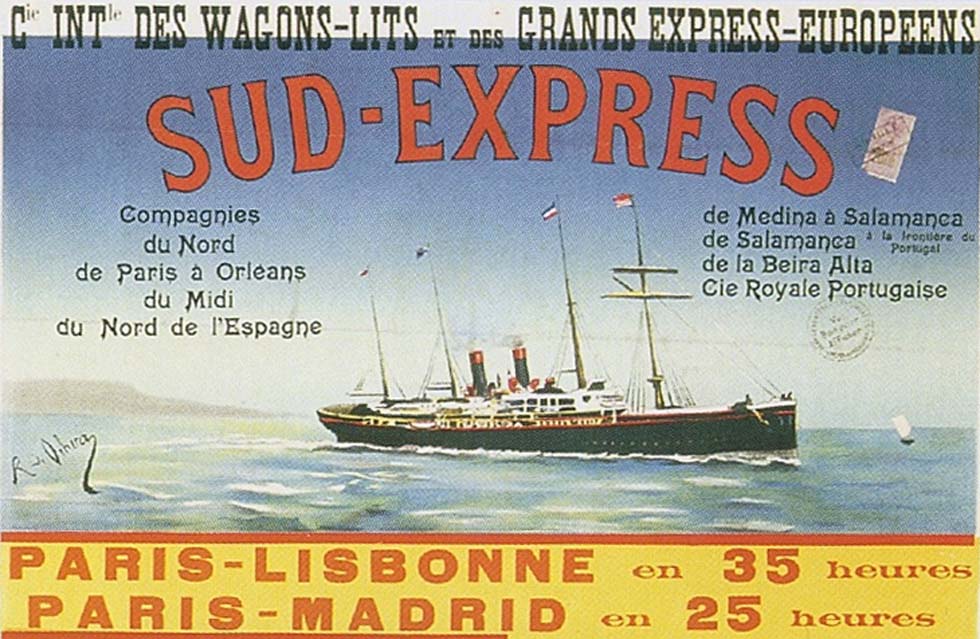
Connection with South Atlantic steamers, an advertisement painted by R. de Ochoa (coll. Juergen Klein)
The shortest way for wealthy Europeans traveling to South America was to start on the CIWL de-luxe train Sud-Express from Paris to Lisbon, connecting there with the steamers of the Royal Mail Line, the Pacific S.N.Co, the French Line, German liners and the Royal Holland Lloyd.
Portugal
The Companhia Colonial de Navegacao of Portugal provided services from Lisbon to the Caribbean, to the River Plate and to Africa. The company maintained a service to Brazil still in the 1950s, but soon it ended. For further activities see chapter Other Africa lines.
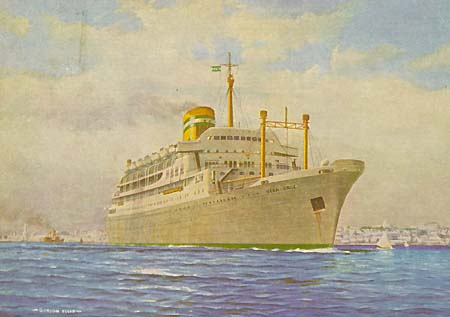
"Vera Cruz", Cia. Colonial de Navegacao (old card, coll. WS)
|
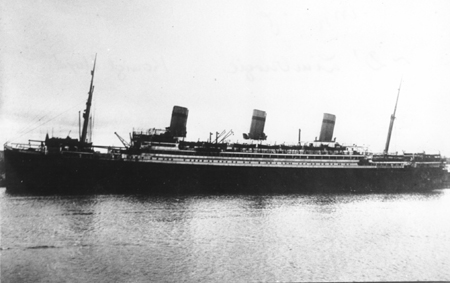
"Limburgia", Koninglijke Hollandsche Lloyd (Deutsches Museum Munich)
|
Netherlands and Belgium
The Holland America Line, engaged in the North Atlantic trade, had added Brazil and River Plate services to their routes in 1888. Before WWI, Bradshaw's timetable listed the competing Royal Holland Lloyd or Koninklijke Hollandsche Lloyd with an Amsterdam - Buenos Aires service. During the war, the company acquired the three-funnel twin-screw steamers "William O'Swald" and "Johann Heinrich Burchard", commissioned by Hapag. In 1922 they were introduced as "Brabantia" and "Limburgia" on the Amsterdam - Buenos Aires route, but with 20,000 tons they proved too large for the limited business and they were sold to United American Lines. After WWI, the Holland America Line entered the South America service in cooperation with Van Nievelt Goudriaan & Co. World War II hit Dutch shipping severely. In the '60s, passenger-cargo services of the Royal Netherlands S.S.Co. or KSNM on the line to the Caribbean and to Suriname were still maintained, while the River Plate services had disappeared.
The Cie. Royale Belgo-Argentine was engaged in services to River Plate. In 1909 the company participated in 'Transatlantica' Rhederei AG of the Menzell Group of Hamburg, which however withdrew from the South America trade in 1912.
USA - South America
American shipping expanded after the end of the Mexican War in 1848 mainly in the
Caribbean. Nevertheless in 1865 the shipping firm W.R. Grace Co. was founded in New York by the Grace Brothers of Ireland, who had started shipping at Callao, the port of the Peruvian capital Lima. In 1890 they introduced cargo shipping to South America and in 1913 they added passenger-cargo services from California to South American destinations.
At the outbreak of WWI the timetable registered the United Fruit Company and the Pan American Route. After opening of the Panama Canal the Grace Line introduced passenger services from New York via Panama to South American West Coast ports in 1916. For that impoverished region the Grace Line steamers, marked by a green funnel, have been a vital contribution. Later the amalgamated Prudential Grace Lines maintained services New York - Chile.
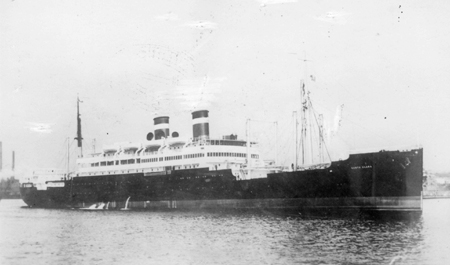 "Santa Clara ", Grace Line (old card, coll. WS)
"Santa Clara ", Grace Line (old card, coll. WS)
The Prince Line was founded in England in 1884 and became a branch of Furness Lines in 1916. Charles R. Vernon Gibbs gave more information: "The New York - Plate service dates from last century. Four motor ships which joined in 1929 were given sufficient passenger accommodation to expedite handling to Buenos Aires". These 10,900-ton ships of the Compass Princes class maintained that service until outbreak of WWII.
Mr. Moore and Mr. Cormack founded in 1913 a shipping company, which opened in 1921 a Philadelphia - Londonderry service, took over in 1926 the Republics Line and offered in 1932 to purchase the state-owned American Republic Lines, which provided cargo services to South America. In 1938 a contract was concluded to operate the passenger steamers "California", "Pennsylvania" and "Virginia" of the Panama Pacific Line on the Buenos Aires route. In September 1938 Moore McCormack Lines was organized, which (apart from operating the American Scantic Line) took over the above-mentioned three ships from American Republic Lines (according to a Web report). Weyers Flottentaschenbuch of 1940 listed the "Uruguay" (ex "California"), the "Argentina" (ex "Pennsylvania") and the "Brazil" (ex "Virginia"), launched in 1929 as turbo-electric steamers of 20,183 tons, employed (e.g. in 1939) under control of the U.S. Maritime Commission between ports of the USA and the South American east coast.
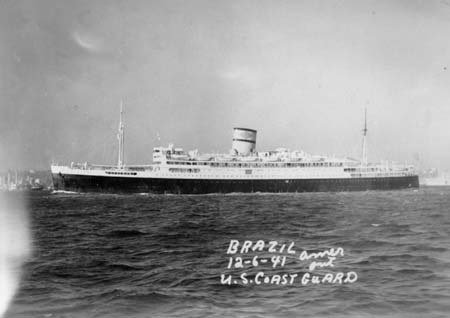
"Brazil" in American Republic Lines colours, 1941 (old card, coll. WS)
|
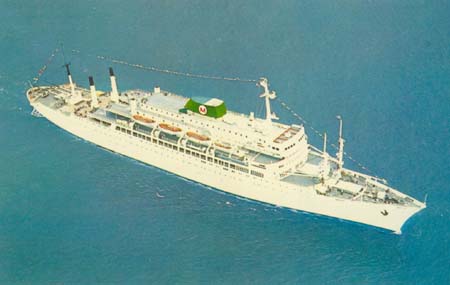
"Brasil" and "Argentina" of 1958, Moore-McCormack (old card, coll. WS)
|
After the war the ships operated in ownership of Moore McCormack Lines on the South American route and additionally on cruises. In 1958 the company introduced the new "Argentina" and "Brasil" (14,984 gt, 24 knots each) on the route New York - Virgin Islands - Rio - Santos - Montevideo - Buenos Aires. The modern interiors of these steamers, conveying exclusively 1st class passengers, were styled by star designer Raymond Loewy. Although the ships were rebuilt in 1963, they were laid up in 1969. Both were sold in 1971 to the Holland America Line, becoming the "Volendam" and "Veendam".
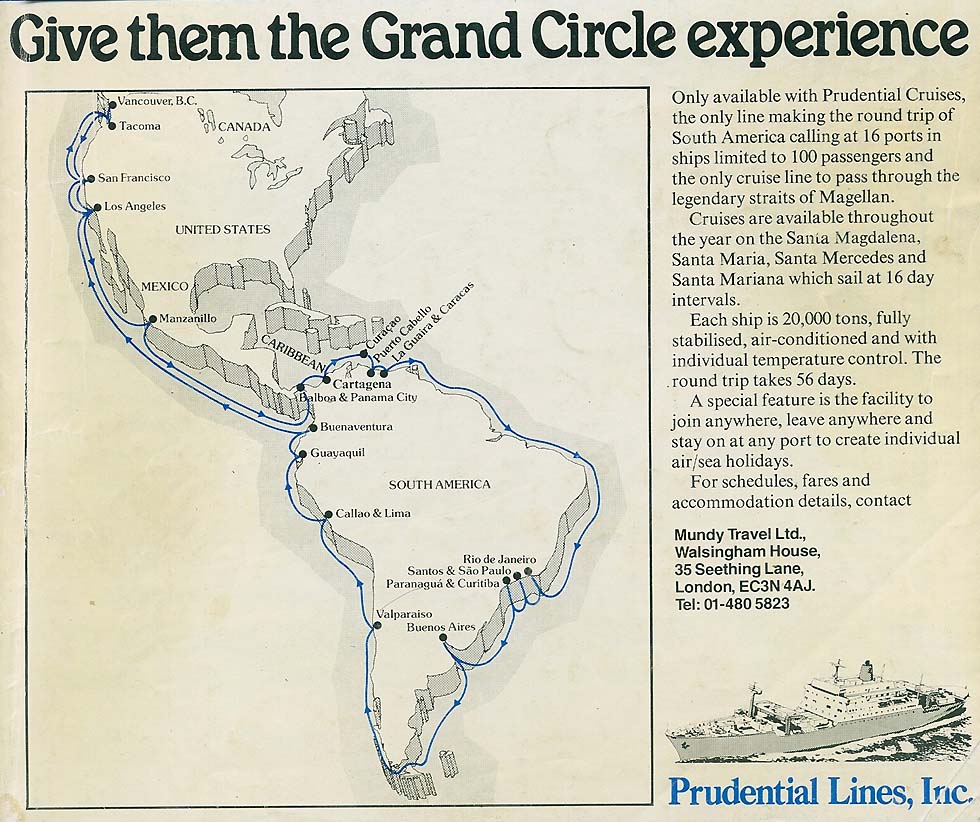
Prudential Lines, 1978 (coll. WS)
Towards the end of the '70s, long after the Moore McCormack liners had disappeared, Prudential Lines advertised regular trips from Vancouver with passenger-cargo vessels of c. 20,000 tons, advertising: "Only available with Prudential Cruises, the only line making the round trip of South America calling at 16 ports in ships limited to 100 passengers and the only cruise line to pass through the legendary straits of Magellan". Then services on a New York - Panama - Valparaiso route were maintained for some time by Delta Steamship Lines.
Latin American Countries
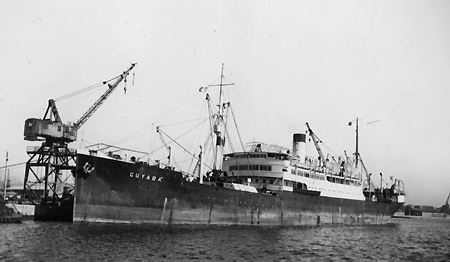
"Cuyaba" of 1906, Lloyd Brasileiro, at Rio (old card, coll. WS)
|
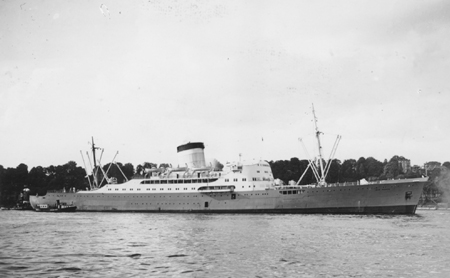
"Eva Peron", Cia. Dodero (old card, coll. Dr. Plantey, WS)
|
Still in the '70s a UN resolution had reason to criticize the discrimination of non-privileged countries by the 'liner conferences'. Joint-ventures with European groups before WWI had been confined to coastal services (see chapter Branch Lines). An exception was the employment of requisitioned German ships by Lloyd Brasileiro on a Rio de Janeiro - Portugal route in 1917, after WWI extended to Hamburg. The "Sierra Salvada" of NDL, requisitioned in 1917 as "Avare", was given away in the early 20s. When in 1941 the motor ship "Orinoco" (1928/9,880 gt) of Hapag was requisitioned at Vera Cruz by the Mexican government, there was no requirement for this ship, renamed "Puebla". After a troubled career she was acquired by the Cia. Transoceanica Argentina S.L.R. , renamed "Juan de Garay". Her fate was described by Laurence Dunn: During her last years she had a white hull and funnels painted in the national colors light-blue with a white ribbon. As the only vessel of her owners she served, together with Spanish ships of the Ybarra Line, ports on the River Plate, in Spain and Italy. In April 1961 she departed from Montevideo for her last Atlantic crossing. The ship was laid up at Barcelona and in 1962 it was scrapped. The Argentine State Line provided services Buenos Aires - New York. Still in 1960 the Cia. Argentina de Navegacion Dodero advertised proudly the steamers "Presidente Peron", sister "Eva Peron" and the more modest "17 Octubre" providing a 'rapid de-luxe' service Buenos Aires - Lisbon - London. In the '60s only the Argentine Lines or Empresa Lineas Maritimas Argentinas (E.L.M.A.) was listed (by C. Frick) with the "Libertad" (1950/12,653 gt, 18 knots, the ex-"Eva Peron") on the Buenos Aires - London route, the 11,500-ton motor ships "Alberto Dodero" and "Yapeyu" of 1951 on the Naples route and the 11,300-ton motor ships "Rio Jachal" and "Rio Tunuyan" of 1950-51 on the Hamburg route. Chile had in pre-war times the Compania Sud Americana de Vapores. At the end of the '70s the ABC Shipping Guide mentioned only second-ranking cargo-passenger services by various companies.
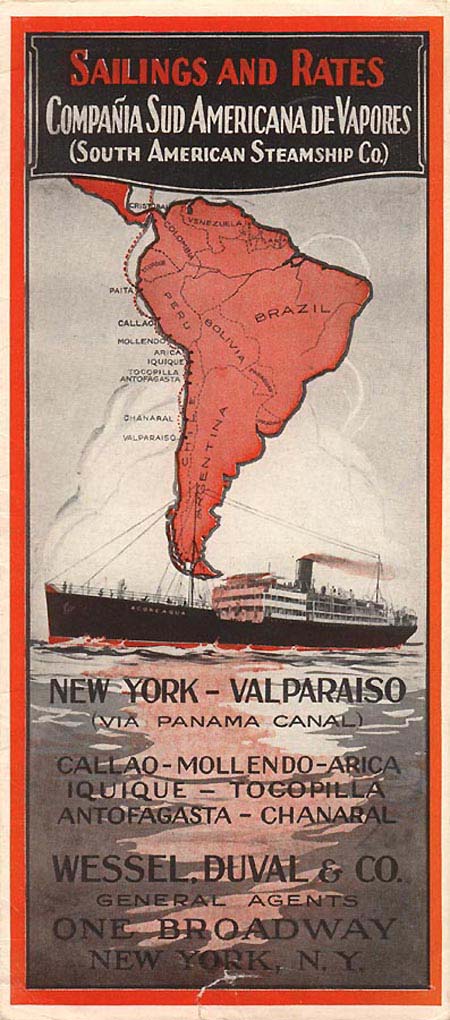 Chilean ad of 1928 (via timetableimages)
Chilean ad of 1928 (via timetableimages)
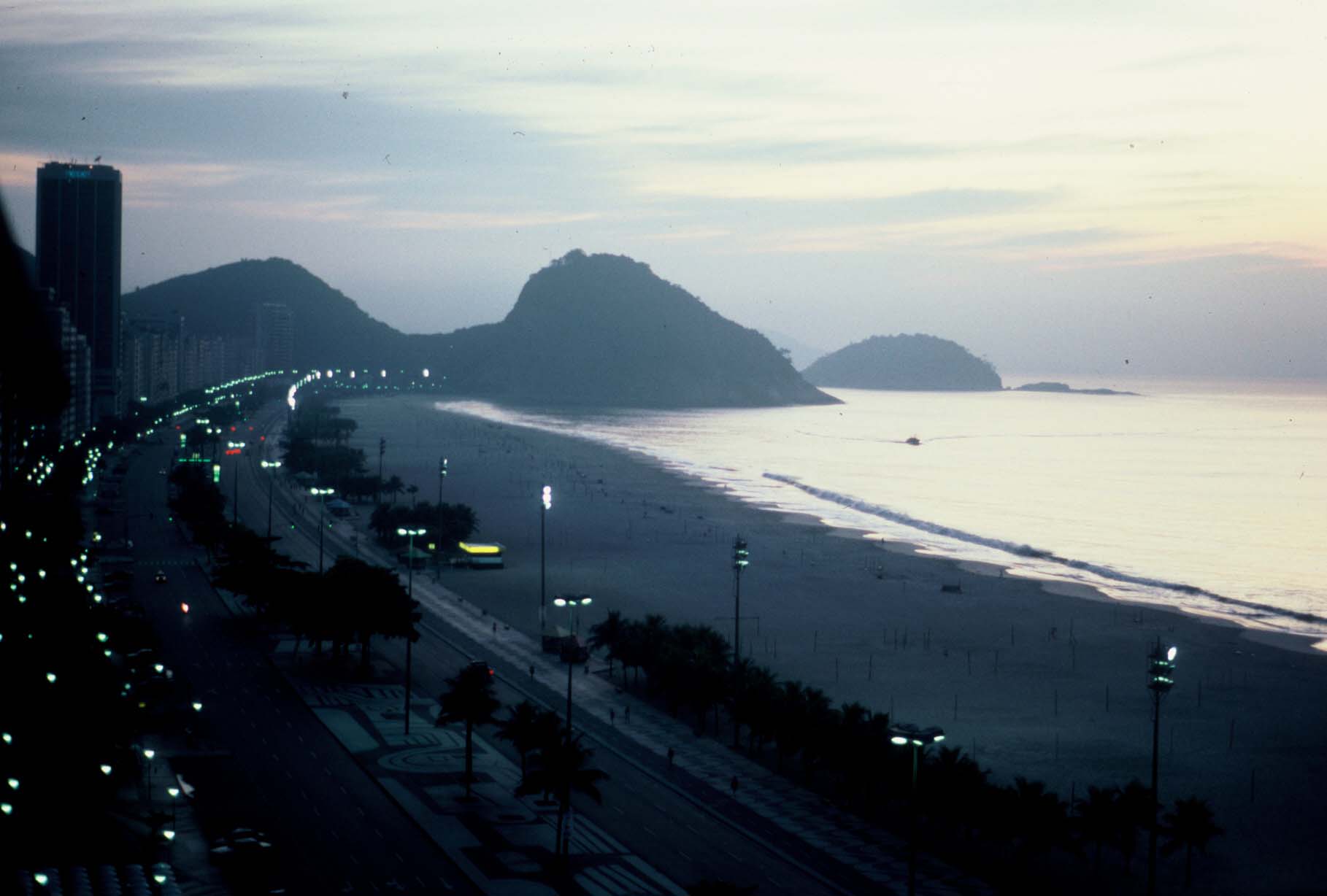
Rio de Janeiro, Copa Cabana (WS)
|